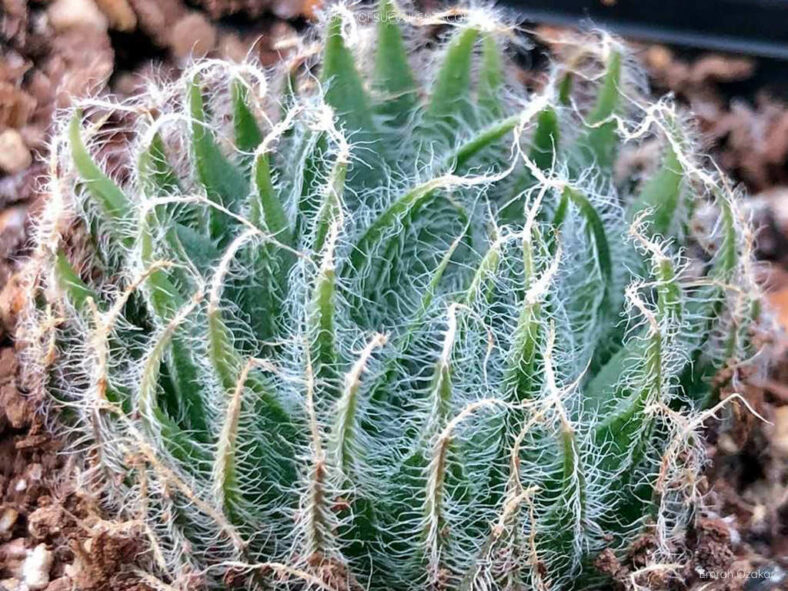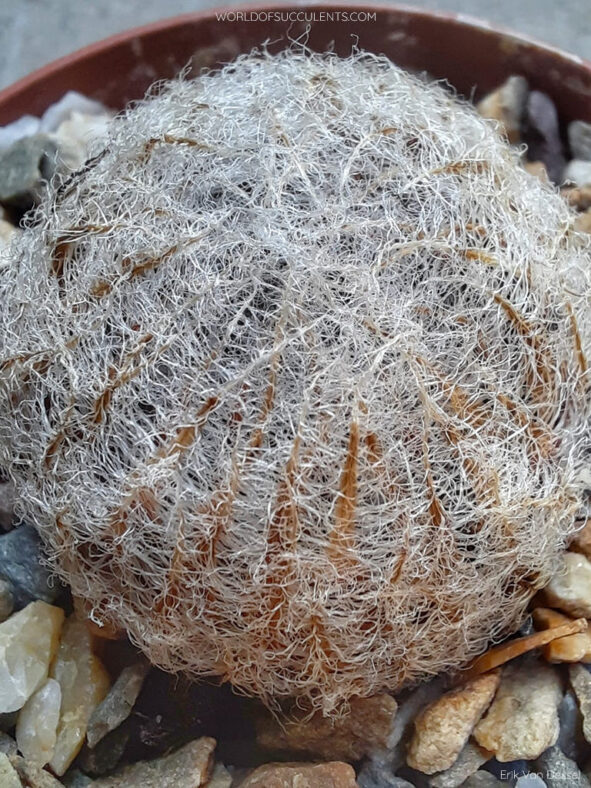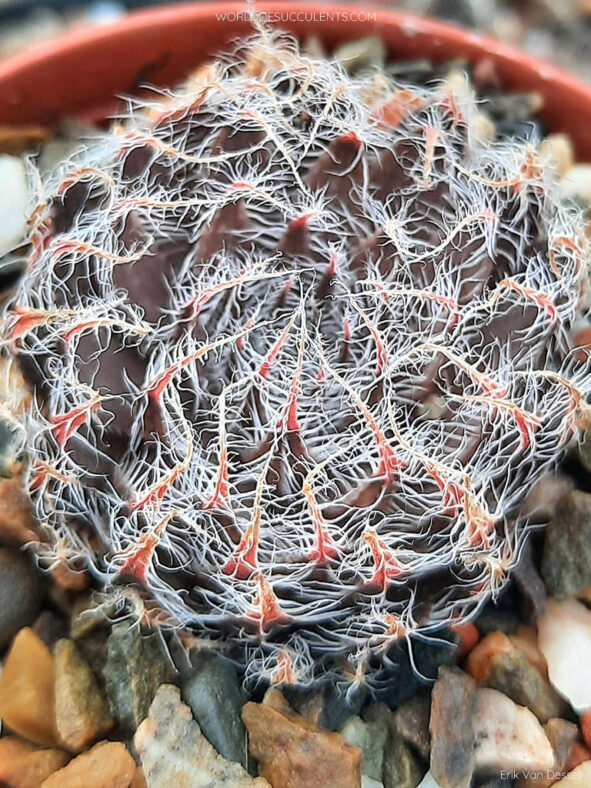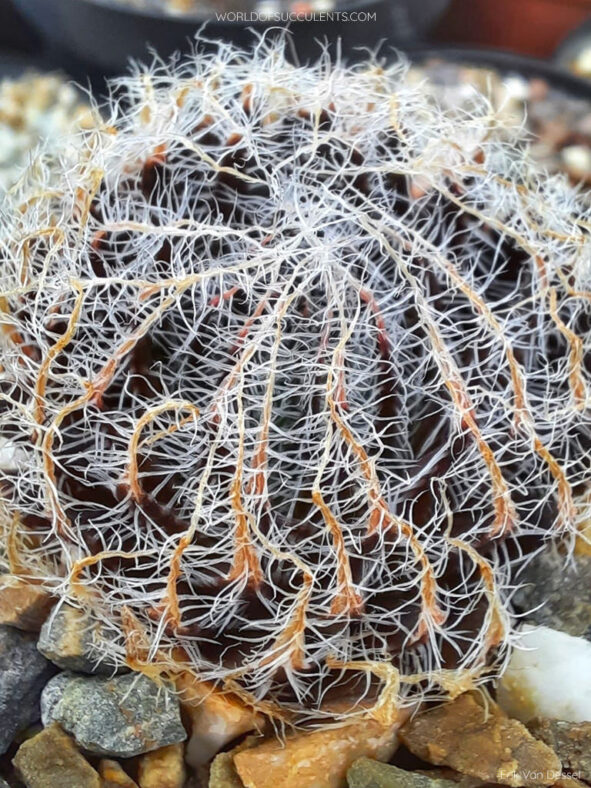Haworthia arachnoidea var. setata is a quite variable pant. It differs from Haworthia arachnoidea var. arachnoidea by being smaller and having dense white bristles that do not blacken when dried. The leaves of this variety are much softer than those of Haworthia arachnoidea var. scabrispina. Additionally, this variety produces offsets very slowly and only when mature, whereas Haworthia arachnoidea var. xiphiophylla does freely.
Scientific Name
Haworthia arachnoidea var. setata (Haw.) M.B.Bayer
Synonym(s)
Catevala setata, Haworthia arachnoidea subsp. setata, Haworthia setata
Scientific Classification
Family: Asphodelaceae
Subfamily: Asphodeloideae
Tribe: Aloeae
Genus: Haworthia
Etymology
The varietal epithet "setata" (pronounced "se-TAH-tuh") means "bristled" and refers to the white bristles on the leaves of this subspecies.
Origin
Haworthia arachnoidea var. setata is native to South Africa. It grows on stony slopes under bushes from Cogmanskloof Pass to De Rust in the Western Cape province.
Description
Haworthia arachnoidea var. setata, formerly known as Haworthia setata, is a small, stemless succulent that forms rosettes of green leaves adorned with dense white bristles along the keels and margins. Initially, this plant grows as a solitary rosette but can later produce offsets at the base, resulting in a small clump. While the rosette can reach a diameter of 5.2 inches (13 cm), it is usually much smaller.
The lance-shaped leaves are incurved and have one or two keels in the upper half. At first, the leaves are erect but become ascending as they age. Each leaf can measure about 1.6 inches (3.5 cm) long, 0.5 inches (1.2 cm) wide, and 0.25 inches (0.6 cm) thick. Under intense light, the leaves take on purple hues. The bristles are translucent and can grow up to 0.25 inches (0.6 cm) long.
During the spring, Haworthia arachnoidea var. setata produces white flowers with brownish-green veins. The flowers can measure up to 0.6 inches (1.5 cm) long and are arranged spirally on slender, unbranched stalks that can grow to about 10 inches (25 cm) long.

How to Grow and Care for Haworthia arachnoidea var. setata
Light: Place the potted plant in a bright area with some protection from the hottest rays of the day. Deep shade tends to weaken the plant over time. If it has spent the winter indoors, gradually move it outdoors into the bright sun to prevent sunburn.
Soil: This plant does not like its roots to remain wet for prolonged periods, so the soil should be well-drained. You can use commercial soil for succulents or make your own potting mix.
Temperature: Haworthia arachnoidea var. setata tolerates warmer summer and cool temperatures in winter. However, it does not like being too cold. It grows best in USDA Plant Hardiness Zones 10a to 11b, with average minimum winter temperatures ranging from 30 to 50 °F (-1.1 to 10 °C).
Watering: Water thoroughly in spring and fall, when growth is most active, and wait until the top of the soil dries out before watering again. Water the plant less in winter, when its growth slows significantly. During the summer, when it is mostly dormant, water it just enough to keep the leaves from shriveling.
Fertilizing: Haworthia arachnoidea var. setata does not require much fertilizer. However, for optimum growth, fertilizing is a good idea. Feed with a water-soluble fertilizer only during the growing season.
Repotting: This plant can stay in the same pot for years. To keep it healthy and happy, repot it into fresh soil every two to three years in spring or fall.
Propagation: The most common method of propagating Haworthia arachnoidea var. setata is by offsets, although it can also be started from seeds. The best time to remove the offsets is during the repotting. For seed propagation, sow the seeds in a well-draining soil mix in spring or fall.
Learn more at How to Grow and Care for Haworthia.
Toxicity of Haworthia arachnoidea var. setata
Haworthia arachnoidea var. setata is considered non-toxic and safe around kids and pets.
Links
- Back to genus Haworthia
- Succupedia: Browse succulents by Scientific Name, Common Name, Genus, Family, USDA Hardiness Zone, Origin, or cacti by Genus
Photo Gallery
Click on a photo to see a larger version.


